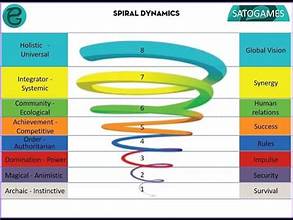Re
Welcome.
I would like to introduce to a map of human development called Spiral Dynamics. It is a framework for understanding how human values and worldviews evolve over time.
A Map is not the Territory
Like any map, this one is not the territory itself. It’s a simplified picture of something vast, alive, and multi-layered. The reality it points to is fractal, multi-perspectival, and holographic—like the *Matrix* itself.
Within this legend is an assumption: that we *can* develop, that we *do* evolve. Most people agree with this to a point—up to the limit of their current worldview.
And here’s the paradox: in “Tier One” of the spiral, each stage holds the conviction that it is right. People at other stages may be seen as simply mistaken—or as dangerously wrong. This “rightness” makes sense inside the stage you’re in, but it can block movement into new ways of seeing.
Where it comes from
Spiral Dynamics began with the research of Clare W. Graves in the 1950s–70s. Graves discovered that as life conditions change, people and cultures shift how they make meaning—what they value, how they see the world, and what they consider worth doing.
Later, **Don Beck** and Chris Cowan refined Graves’ work into the color-coded spiral we use today. Ken Wilber integrated it into his ‘Integral Theory’ as one of many lenses for seeing the big picture.
Why it’s Useful
The spiral is not about IQ, personality, or “better vs. worse.”
It’s about fit; which worldview best meets the challenges of your current reality. Every level has gifts and blind spots. You can move between them, and in healthy growth, you keep what works from earlier levels while expanding into what’s next.
Beyond Tier One
The spiral has two visible tiers and a rumored third.
Tier One (Beige through Green) is where most of humanity operates. Each stage here believes it holds the truth.
Tier Two (Yellow and Turquoise) brings a shift: recognizing that all stages are valid responses to specific life conditions. It’s possible to visit these higher stages, but sustaining them—making them home—is rare.
Tier Three, suggested by Wilber, is largely unmapped and may represent an entirely new kind of human identity.

How to Read the Spiral
Each color represents a center of gravity—a cluster of values, ways of thinking, and decision-making patterns.
Beige – Survival: instincts and immediate needs.
Purple – Tribal: belonging, ritual, safety in the familiar.
Red – Power: action, strength, asserting will.
Blue – Order: structure, rules, purpose.
Orange – Achievement: results, innovation, progress.
Green – Pluralism: inclusion, empathy, shared power.
Yellow – Systems: integration, flexibility, fit-for-purpose solutions.
Turquoise – Holism: interconnectedness, global stewardship.
These are not boxes to live in—they’re more like wavelengths you can tune into. Most of us operate from one or two primary stages but can visit others when conditions call for it.
Why the Leap from Green to Yellow Matters
If you’ve lived in Green, you value compassion, diversity, and fairness. But moving into Yellow asks for something counterintuitive: to hold compassion and set boundaries, to honor differences and make decisive choices, to see context instead of one-size-fits-all truths.
It’s a leap many resist—not because Yellow is “harder,” but because it rewires how the ego relates to identity and belonging.
Want to Explore More?
Here is the link to a blog where I break down each stage in the spiral dynamic map.
We are also working on an Assessment tool to help you find which stage(s) you reside in.
If you are really interested in doing a deeper dive I recommend this article by Susanne Cook-Greuter. Her map and stages of development fit like a glove inside the spiral. Here is the link to the article.
Link to article: